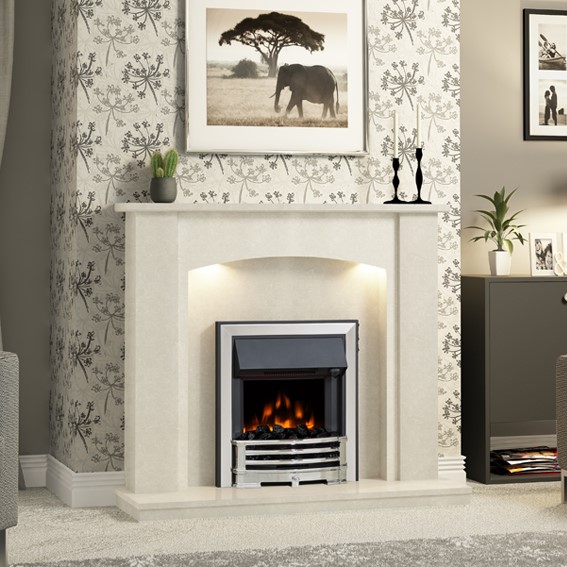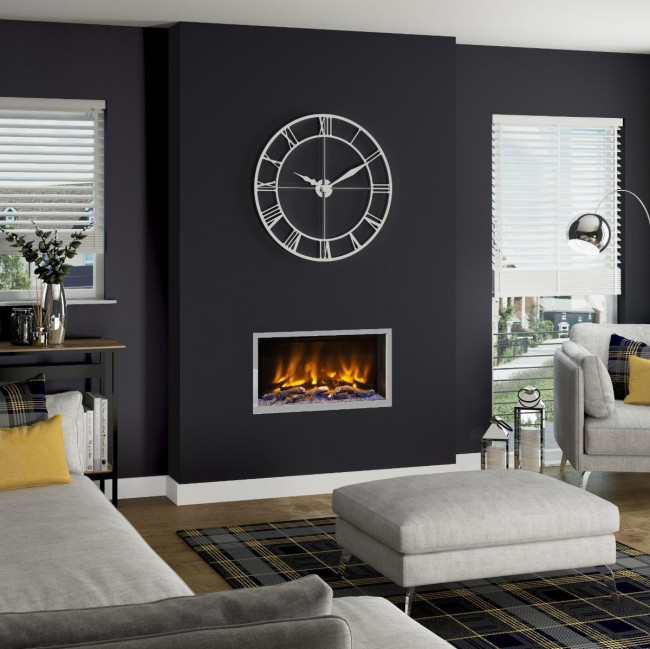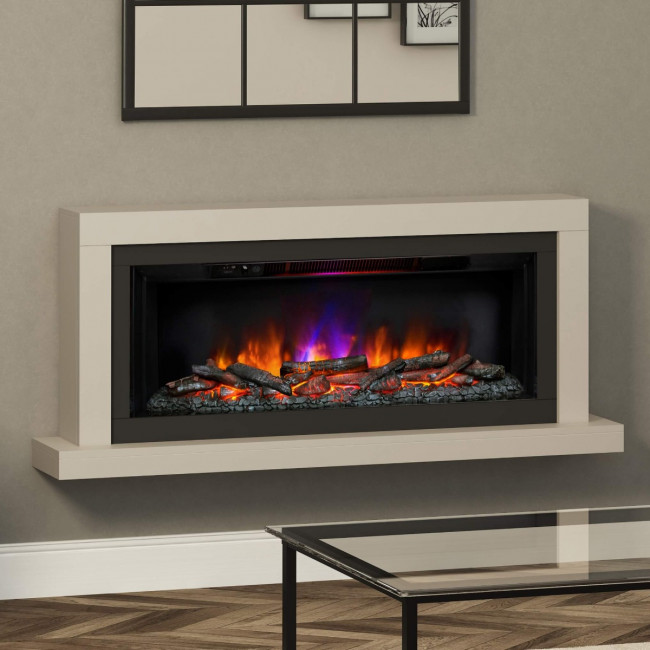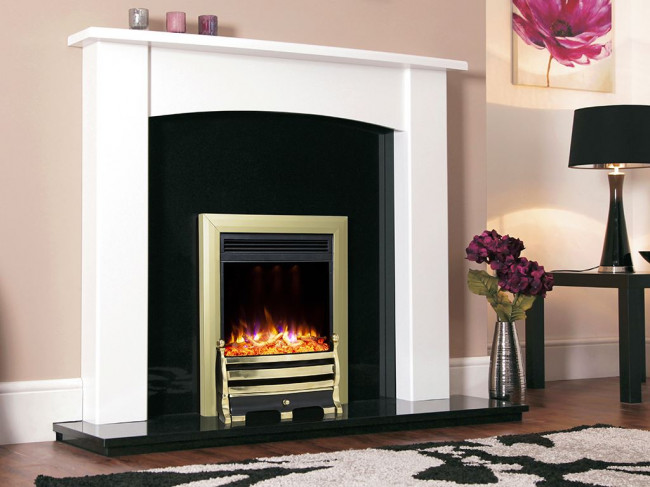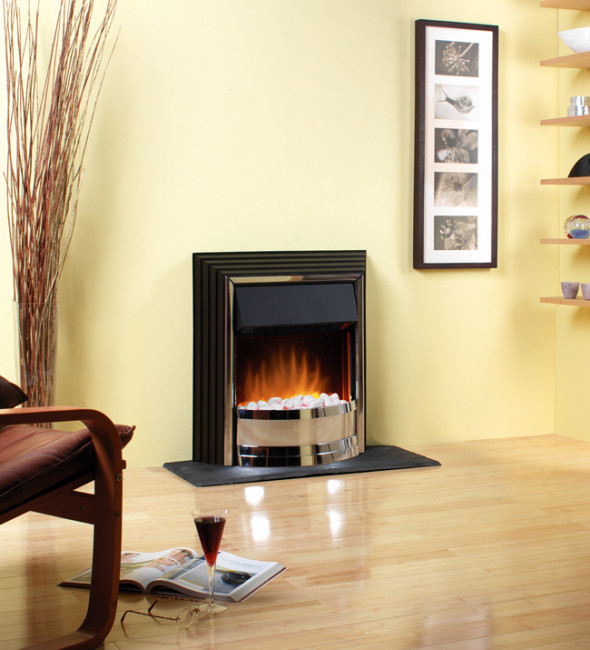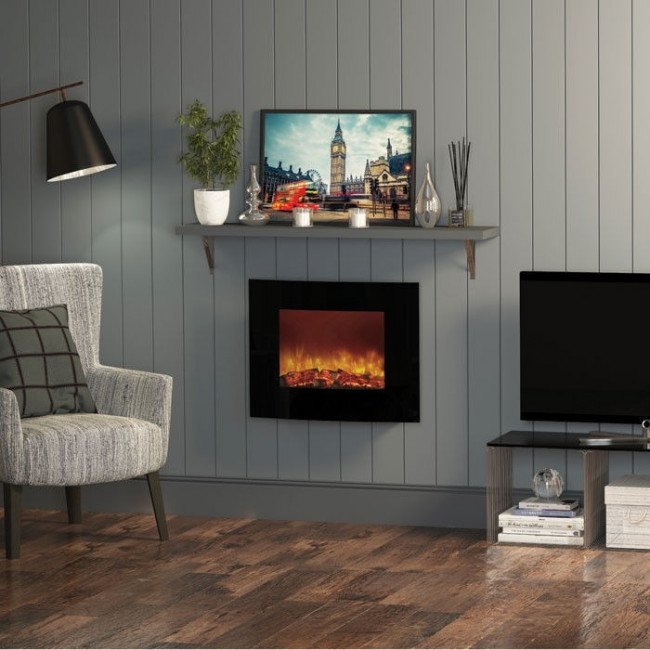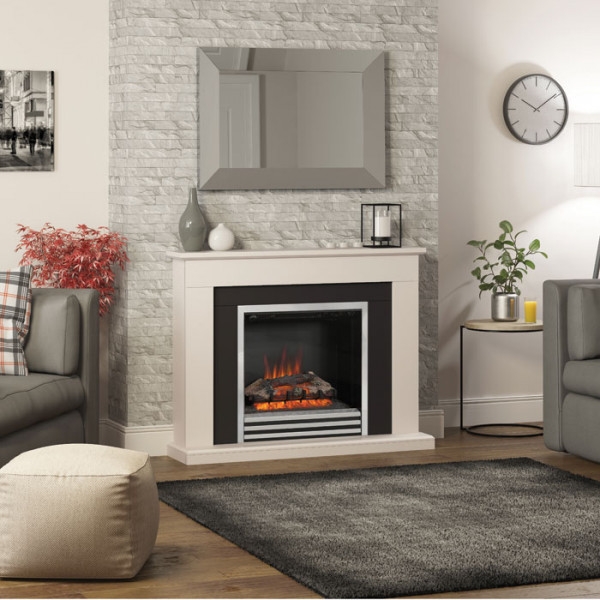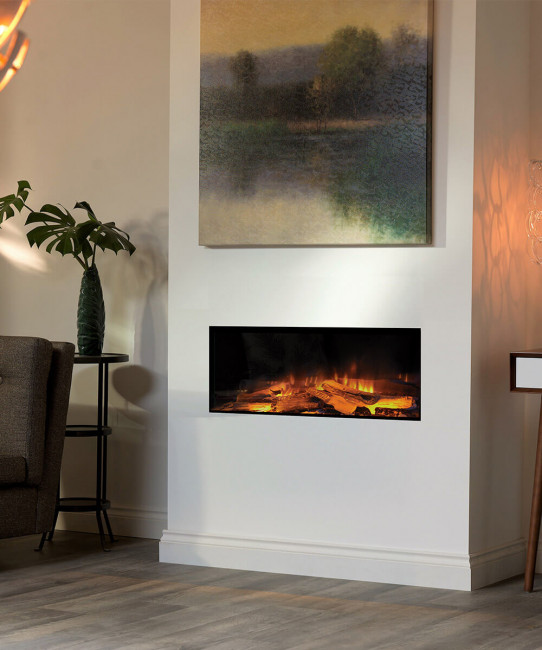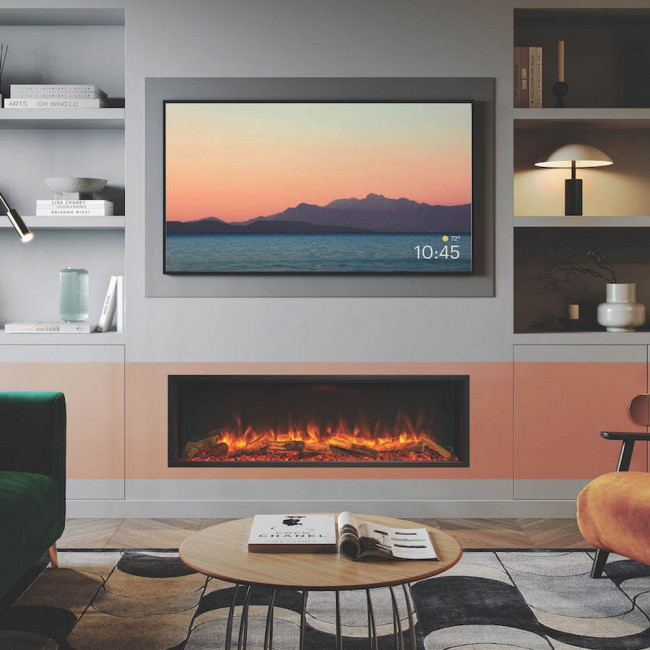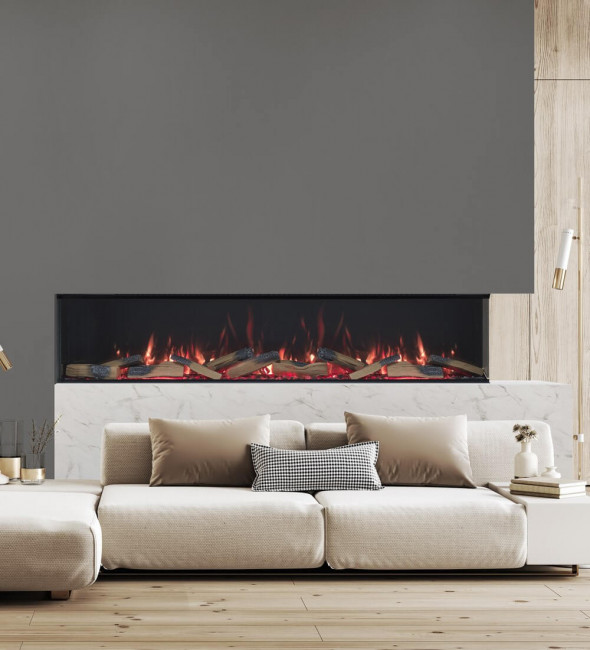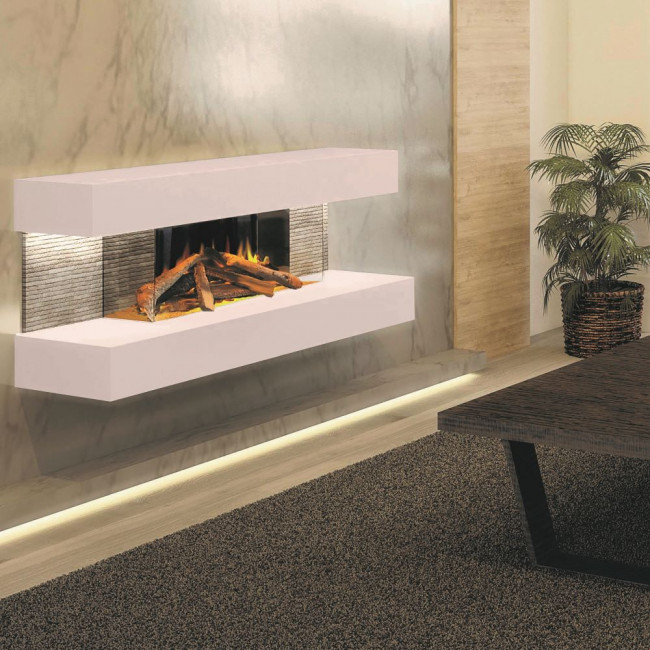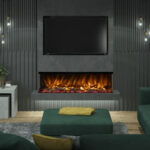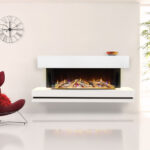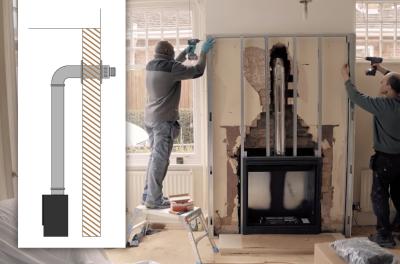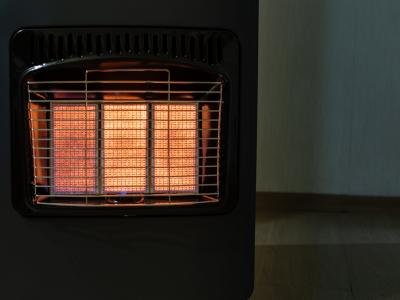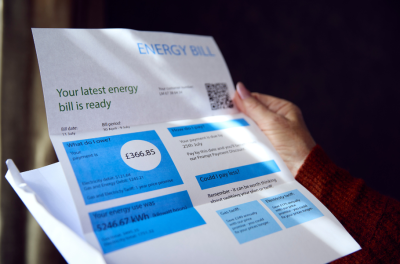We use cookies to improve your experience and our business. See our privacy/cookie policy or continue browsing to accept our use of cookies. View our cookie policy.
How To Choose The Right Electric Fire - Buying Guide
The crackling warmth of a fireplace adds character and ambience to any room. But what if you want those cosy vibes without the traditional setup? If that's the case, an electric fire might be your best choice. Electric fires have emerged as a modern solution, offering all the luxury of warmth without fuss. In this buying guide, the Direct Fireplaces team take you through the essentials to consider when buying an electric fire.
Why choose an electric fire?
There are several reasons why you might like an electric fireplace for your home:
No fuss, no mess
While cosy and romantic, traditional fireplaces come with challenges like ash cleaning, wood stocking, and regular maintenance. On the other hand, electric fires offer all the charm without the chores. Plug it in, switch it on, and you're ready!
Installation flexibility
One significant benefit of an electric fire is its installation flexibility. Suppose your home doesn't have a chimney or a flue. In that case, there's nothing to worry about – you can install an electric fire in a wide range of settings, from small flats to older homes where the fireplace has been plastered over. This adaptability makes them a favourite choice among homeowners looking for a hassle-free solution.
Energy efficiency
While traditional fireplaces lose a considerable amount of heat through chimneys, electric fires are 100% efficient at the point of use. What does this mean for you? Because all the energy the fire consumes is directly used to warm your room, you get the most for your money. Not only is this efficiency kinder to the environment, but it can also lead to potential savings on your energy bills.
Safety
Safety is a top priority for households with children or pets. Electric fires don't produce a real flame, therefore reducing the risks associated with open fires. What's more, they don't release any harmful emissions or carbon monoxide. The result? The air inside your home remains clean and healthy.
Control options
Gone are the days when you must stoke the fire to maintain a consistent heat. Instead, with a modern electric fire, you'll get access to a wide range of control options. From adjusting heat settings to tinkering with the visual effects, everything can be controlled – often from the comfort of your seat with a handy remote. Some electric fires even offer programmable timers. With this control feature, you can set the fire while you're out, ensuring that you return home to a warm living room on chilly evenings.
Read more: Can You Control Your Fireplace Using a Smartphone?
Aesthetic appeal
Beyond their functional advantages, electric fires are a design marvel. Whether you want a subtle heating solution or a flashy centrepiece for your living room, there's an electric fire design to suit every taste. Want to create an atmosphere that rivals traditional fireplaces? With their realistic flame effects, anything is possible with a modern electric fire.
Understanding electric fire heat output
The heat output of an electric fire is a pivotal consideration when purchasing. It's often measured in kilowatts (kW). Let's explore why heat output matters and how to choose the right one for your needs.
What is heat output?
Simply put, heat output signifies how much warmth an electric fire can produce. The measurement in kilowatts indicates how effectively it can heat a room. The higher the kW rating, the greater the amount of heat produced. Most electric fires have a heat output of between 1-2kW.
Why is it essential?
- Room size: The room size you want to heat will dictate the kW rating you should consider. A large living room will need a higher kW rating than a small bedroom. Bear in mind that with most electric fires, the heat output is designed to be complementary rather than a primary heat source. However, selecting an output that matches your room size will ensure efficient and effective heating.
- Energy consumption: An electric fire with a higher kW rating will use more electricity. Knowing the heat output can help you gauge potential energy costs and manage them more effectively.
- Comfort levels: A balanced heat output ensures that the room neither feels too hot nor too cold. Getting it right contributes to consistent comfort levels, making your living spaces more enjoyable.
Learn more: Which Electric Fireplace Gives the Most Heat?
How to choose the correct electric fire heat output
- Assess your space: Measure the room where you plan to install the electric fire. Larger areas typically require electric fires with a higher kW rating.
- Insulation matters: Well-insulated rooms retain heat better. Because of this, you might not need a high kW rating if your home has good insulation.
- Consider room usage: If the room is used infrequently, such as a guest room, you might opt for a lower kW rating. On the other hand, for high-traffic areas like the living room, you might prefer a more powerful electric fire.
What electric fire styles are there?
When it comes to electric fires, it's about more than just functionality. Style is a huge factor in your decision, too. The right electric fire can complement your décor, becoming a focal point in your room or seamlessly blending into its surroundings. Let's look at the diverse styles available to help you find one that resonates with your interior design tastes.
Inset electric fires
Inset electric fires like the Eclipse Chrome, the Dimplex Danville, and the Gallery Collection Hopton are designed to be partially inserted into a wall or a pre-existing fireplace opening. This leaves only the front face of the fire visible.
These electric fires are ideal for those who want a sleek, integrated look that doesn't protrude much from the wall or those with a traditional chimney breast and fireplace opening.
Shop inset electric fires
Freestanding electric fires
As the name suggests, freestanding electric fires like the Dimplex Castillo stand freely. You can position them against any wall or even move them between rooms.
They are available in various designs, from modern to traditional. They're an ideal choice for those lacking a fireplace recess – their versatility is their main selling point.
Shop freestanding electric fires
Wall-mounted electric fires
These electric fires, such as the Celsi Flamonik Rapture, the Dimplex Bach, and the Flare Amari, are mounted directly onto a wall, similar to a flat-screen TV. They typically sport a contemporary, sleek design – sometimes with backlighting options to create mood lighting.
Wall-mounted fires are ideal for modern homes or spaces that want a touch of sophistication. They're also excellent for those who prefer to keep floor spaces clear.
Shop wall-mounted electric fires
Electric fire suites
Suites like the Celsi Ultiflame VR Adour Aleesia Illumina, the Katell Luminess, or the OER Monaco are all-in-one solutions that come with the fire and the surrounding framework, often resembling a mantelpiece. They can be a blend of both traditional and modern designs.
Let's say you want a complete fireplace look, without any construction or structural changes to your room. In that case, this might be the best option for you.
Shop electric fireplace suites
Hole-in-the-wall electric fires
As the name suggests, electric fires like the Celsi Ultiflame VR Elite, the Evonic e900 GF, and the Gazco eReflex 55R are designed to be inset into a wall. The result? A flush, sleek, and space-saving look. Essentially, the fire becomes a part of the wall, offering a minimalist, modern aesthetic that maximises floor space and creates a striking visual centrepiece.
Hole-in-the-wall electric fires are ideal for rooms where floor space is at a premium. While they’re usually positioned at eye level for a dramatic effect, you can install them lower or higher based on room design and personal preferences.
Shop hole-in-the-wall electric fires
Media wall electric fires
These fires, such as the Vision Futura 1500, the Evonic Halo 1500 XT, and the Elgin & Hall Pryzm Arteon 1500 3SL, are integrated into custom-built wall units that accommodate televisions, sound systems, and sometimes shelving or cabinetry. They offer a cohesive look where the fireplace and the media systems coexist harmoniously on the small wall. The elements are often highlighted by decorative panels or ambient backlighting.
Learn more: Media Wall Electric Fire Buying Guide
Media wall electric fires are best for contemporary homes seeking a unified environment and relaxation hub. This might be ideal for you if you want to create a central focal point in your living area, combining media entertainment and fire warmth.
Shop media wall electric fires
Electric fire flame effects
One of the electric fires' most enchanting features is their captivating flame effects. While traditional fires win hearts with their natural glow, electric fires bring a palette of visual experiences that elevate the ambience of any room. Let's explore the different flame effects available when choosing an electric fire.
Standard LED flames
Using energy-efficient LED lights, these produce a consistent, warm, and realistic flame. LED flames can mimic the flicker and movement of real flames convincingly.
LEDs are known for their longevity and energy efficiency. So, with this option, you'll save on replacement costs and energy bills.
3D flame effects
Electric fires generate 3D flames using layered effects and projections. The result? An illusion of real depth, height, and log placement. This depth makes the fire feel more spacious and authentic.
What's more, 3D effects often come with customisable backgrounds, allowing you to adjust and tailor the visuals based on your preferences.
Multi-coloured flames
These electric fires break from the traditional orange and yellow flames, allowing you to switch between various colours, from serene blues to vibrant purples.
An electric fire with a multi-coloured flame effect is ideal for those who love customisation or want to set a particular mood. They can turn your fireplace into a dynamic piece of art.
Read more: The Best & Most Realistic Flame Effect Electric Fires
Understanding electric fire running costs
The long-term impact on your utility bills is essential to consider when adding an electric fire to your home. While electric fires bring several benefits, understanding their running costs can help you make an informed decision and manage your budget effectively.
Understanding consumption
The power of electric fires is commonly measured in kilowatts (kW).
An electric fire rated at 2kW, when run continuously for an hour, will consume 2 kilowatt-hours (kWh) of electricity.
Your electricity tariff will indicate how much you pay per kWh. For example, if your rate is 15p per kWh, running a 2kW electric fire for an hour would cost you 30p.
Learn more: A Guide to Choosing The Most Economical Electric Fire
Factors influencing costs
- Heat output: The kW rating of your electric fire determines how much it'll cost you to run. A higher kW rating means more heat but also higher consumption.
- Duration of use: The longer you run your electric fire, the more it will cost.
- Electricity tariff: Your cost per kWh can vary based on your energy provider and the tariff you're on. Review your tariff and compare providers regularly to ensure you get the best deal.
- Efficiency features: Modern electric fires have features like thermostats and timers. These can help regulate usage, turning off the appliance when a set temperature is reached or after a specified duration.
Cost-saving tips
- Zone heating: Most electric fires cannot heat an entire home. Instead of trying to achieve this, use your electric fire to complement your central heating system or just heat one room.
- Thermostat usage: Set a comfortable temperature and let the built-in thermostat maintain it. The fire will cycle intermittently to keep the room at this temperature, preventing unnecessary use.
- Regular maintenance: You should keep your electric fire clean and well-maintained to ensure it runs efficiently. Dust and debris can make the appliance work harder, consuming more electricity.
- Flame-only mode: Many electric fires allow you to use the flame effect without the heat. This provides all the ambience of a fire with minimal energy consumption.
Installing your electric fire
One of the most attractive things about electric fires is their relative ease of installation. Unlike traditional fires that require chimneys, flues, and sometimes significant structural work, electric fires offer a simpler alternative. However, following proper installation guidelines is essential for a seamless, safe, and efficient setup.
- Positioning: Decide where you want the electric fire to be. It should be near a power socket to avoid trailing wires and potential trip hazards.
- Space requirements: Check the manufacturer's recommendations for space requirements, ensuring adequate clearance around the fire. This is important for proper ventilation and to prevent overheating.
- Wall strength: If you opt for a wall-mounted style, ensure the wall can support the weight of the electric fire.
Read more: What Are the Easiest Fireplaces to Install?
How to install your electric fire: Step-by-step
Unless you've chosen a fire with a more complicated setup, such as a corner installation, hole-in-the-wall or media wall fire, you can easily install most electric fires yourself. Here are the steps involved:
- Unpack and inspect: Unpack the electric fire and review all parts. Plus, it's also an excellent time to consult the user manual to familiarise yourself with the components and specific installation steps.
- Secure the bracket: For wall-mounted electric fires, the first step usually involves fixing a bracket to the walls. Use appropriate wall plugs and screws. Also, ensure the bracket is level.
- Connect to power: It's a good idea to plug your fire into the mains before hanging or placing your fire. Switch it on to test it and ensure all functions are working correctly.
- Fix the fire: Depending on the design, either hang the fire on the bracket or position it in its desired place. For inset models, slide the fire into the opening, ensuring it fits snugly and securely. Always provide adequate ventilation around the electric fire, particularly if positioned in a recess or alcove.
- Final tests: Once your fire is installed, test all the functions again. This includes heat settings, flame effects, and additional features like backlighting or remote controls.
- Cable management: If there are any visible cables, consider using trunking or cable tidies to keep them out of sight and reduce tripping hazards.
Shop electric fires at Direct Stoves today
Find everything you need at Direct Stoves if you're looking for a classic inset electric fire, a handy electric suite, or a luxury electric fire for your media wall. Our massive range of electric fireplaces has something to suit every homeowner.
What's more, we offer free UK mainland delivery and no-hassle 14-day returns, and you can spread the cost of your new electric fire with our finance options.
Got more questions? No problem! Our customer service team is here to help. Call 0161 376 4181 or email [email protected]. Want to see some fires in person? Visit our Cheadle, Bromsgrove, or Stockport showrooms to explore our ranges.
You might also like:
- Media Wall Electric Fire Buying Guide
- 5 Electric Fires With 'No Heat' Settings for Summer
- A Guide to Choosing The Most Economical Electric Fire
- How Do You Install a Wall-Mounted Electric Fire?
- Which Electric Fireplace Gives the Most Heat?
- Our Best Slimline Electric Fires for Tight Spaces
- The Best White Electric Fire Suites for All Homes
- Our Best Three Sided Electric Fireplaces for Media Walls
- The Best Log Effect Gas and Electric Fires
- The ‘Plug In & Go’ Electric Fireplaces You Can Install in Minutes!
- Guide to Inset Gas & Electric Fires
- The Best Small Electric Fireplaces for Winter
- Gas or Electric Fires: Which is Best?
- The Best Electric Fire Suites For All Budgets
Joanna Humphreys
Latest posts by Joanna Humphreys (see all)
- What’s Included in a Balanced Flue Gas Fire Installation? - April 3, 2024
- How Long Do Gas Fires Last? - February 1, 2024
- How Much Does it Cost to Run a Gas Fire in 2024? - January 16, 2024

